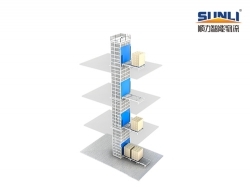Most projects of intelligent three-dimensional warehouse are operated around automatic equipment such as conveyors and stackers. Since it is a piece of equipment, it needs to have its capacity range. For example, if the planned rated weight is 1 ton, if it is 2 tons, it cannot be warehoused normally. So, how to prevent the storage space of the intelligent stereoscopic warehouse from being overweight?
1. It is recommended to add a detection device on the inlet conveyor
Weighing machines are usually used to test the weight. Once it exceeds 5% of the rated weight, it is not allowed to enter the warehouse. There are two ways to achieve this:
1. The electronic control device is controlled by itself. For example, if 1 ton is set, it is not allowed to enter more than 1 ton;
2. Under the control of the upper software, once the pallet is detected to be overweight, it is not allowed to release, or even to stack for registration.
The upper software control is recommended here, mainly because the software control is more simple and flexible, low cost, and can expand some functions. In addition, in order to carry out fine control, even when dispatching the action of the stacker, the weight of the goods will also be transferred to the stacker, so that the stacker can automatically adjust the parameters of the inverter according to the weight of the goods, so as to walk out of the starting brake curve with a higher cost performance ratio (balance of speed and power consumption).

2. Set on the frequency converter corresponding to the inlet conveyor motor
For example, reduce the large threshold value of torsional torque, and alarm and stop moving once overweight. This parameter can be opened to the upper layer through the communication protocol, and different parameters can be set for different entrances, so that the upper layer can judge flexibly; Or, in order to change the angle, when the inbound conveyor is running, PLC will open the torque parameter of the inverter to the upper information system. The upper system draws the curve function relationship in advance according to the torque relationship between goods with different weights and motor output, so that the weight can be estimated according to the torque value each time. In case of overweight, the upper system will give an alarm and indicate that the current data transmission has stopped.
This method is much cheaper than weighing machines. Although the weighing machine is theoretically effective, it also has disadvantages:
1. Cost: This is the main reason;
2. Debugging: In fact, for the cost of domestic weighing machines, many testing equipment still stay in the serial communication mode, which brings great trouble to debugging and installation;
3. Control: The weight can be electronically read and uploaded to the upper layer, or the upper layer can read by itself, but the release control of the tray needs to be OK. Do not calculate the weight of the previous tray on the current tray to avoid conspicuous situations.
3. Pure software estimation control
The software knows what and how many items are in the tray of the intelligent three-dimensional library, and the weight of each item. When registering in the warehouse, once the overweight is calculated, the task cannot be registered. This will have some preventive effect, but the trouble is that the customer's maintenance volume has increased, and the total amount of each single piece needs to be calculated. If there is packaging, this part of the weight calculation will also have errors.














